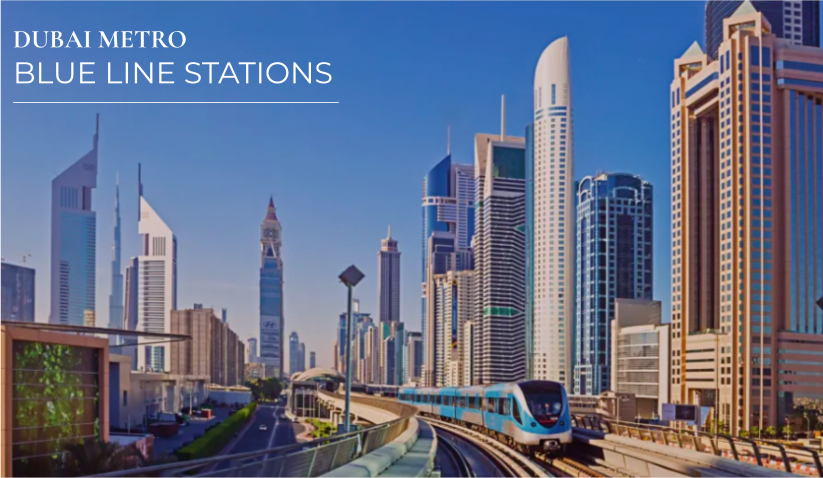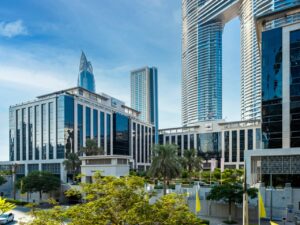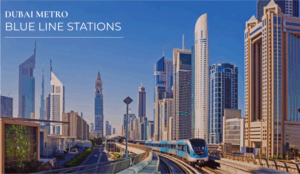Dubai Metro’s Blue Line: A Masterclass in Anticipatory Investing
Real estate moves in cycles. But every now and then, it moves in straight lines—railway lines, to be precise.
The newly announced Dubai Metro Blue Line, a 131-kilometre megaproject connecting nine key districts, is not just a transportation development. It’s a structural shift in how urban Dubai will be experienced, priced, and lived in. And for the discerning investor, it’s an early signal of compounded opportunity.
According to market data from Property Monitor and Betterhomes, rents in the nine districts impacted by the Blue Line have already jumped 23% on average since the government’s announcement in late 2023. This includes standout zones like:
- Dubai Creek Harbour: +30%
- Al Warqa, Silicon Oasis: +22–28%
- International City, Ras Al Khor, Dubai Festival City, DIP: +15–21%
And we’re still in year one of a multi-year buildout.
The Blueprint Behind the Price Action
Dubai’s 2040 Urban Master Plan envisions a city of interconnected hubs, where over one million residents will benefit from this single new line. This is more than transit—this is a redefinition of value corridors.
Back in 2009, the opening of the Red Line catalysed a significant rise in property values across metro-adjacent districts—most notably within a 500–800m walking radius of stations. The same trend is emerging here, but this time with two added forces at play:
- Digital transparency: Investors today move faster, with more data and mobile-first listing platforms. Price lag is shorter.
- Urban experience shift: A new generation of tenants—remote-capable, time-conscious, and less car-dependent—is actively prioritising metro access over square footage.
This isn’t just a market reacting. It’s a demographic revaluing.
Redwood Heritage Perspective: The Strategy Beneath the Story
At Redwood Heritage, our approach is not reactive—it is anticipatory. Legacy investing requires clarity on when, where, and why value concentrates.
Our read on the Blue Line opportunity is structured across three actionable dimensions:
1. Yield Compression as a Signal, Not a Ceiling
Studio units in connected districts have seen rents jump from AED 27K to AED 36K per year. On paper, yields are tightening—but this should not deter capital. The increase reflects confidence, not saturation. Smart capital knows that price appreciation often trails behind rental realignment in metro zones.
2. Time Arbitrage Between Announcement and Delivery
We are in a 4-year window where perceived value and actual value are still misaligned. Most price discovery will happen between station finalisation and operational testing—not after the ribbon-cutting ceremony. Now is the window to structure entry.
3. Legacy Mapping: Not All Metro Zones Are Equal
We analyse not just metro proximity but urban integration:
- Are the zones within walkable grids?
- Are they buffered by parks, schools, retail, or water?
- Is the tenancy base stable or transient?
- Will families stay, or are they merely passing through?
This difference defines whether your investment outperforms over 10 years—or peaks in 3.
What Should Investors Do Now?
- Avoid blanket exposure to ‘metro-connected areas’—instead, rank zones by infrastructure intensity, livability factors, and projected absorption rates.
- Anticipate tenant preferences: Connectivity is the new parking. Micro-units near metro stops will increasingly attract professional tenants with strong income profiles but lower car dependency.
- Use this moment to restructure existing portfolios: divest from stagnant, overbuilt communities and redirect capital toward undervalued, soon-to-be-connected districts.
- Structure your acquisition with future tax and estate planning in mind—especially if you are buying in a personal name today but envision long-term intergenerational use or asset protection.
The Blue Line is not just about rails—it’s about recalibration.
Dubai is investing not in transport, but in fluidity, accessibility, and time efficiency. And the market is responding exactly as it should: by elevating the value of access.
For families and investors who think in decades, not quarters, this is a generational opportunity to align your real estate strategy with where the city is truly going—not just where the skyline is today.
At Redwood Heritage, we don’t follow the market—we structure ahead of it.



